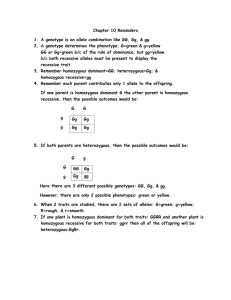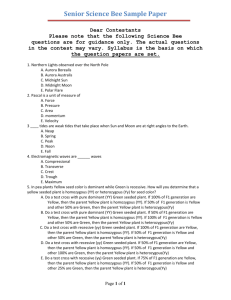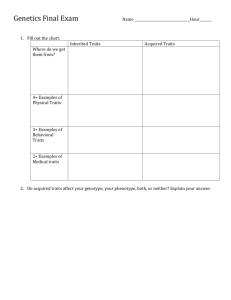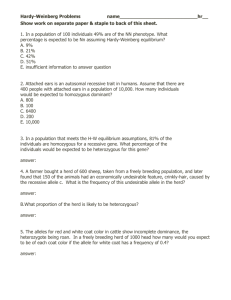BIOL 112 - Introduction to the Cell
advertisement
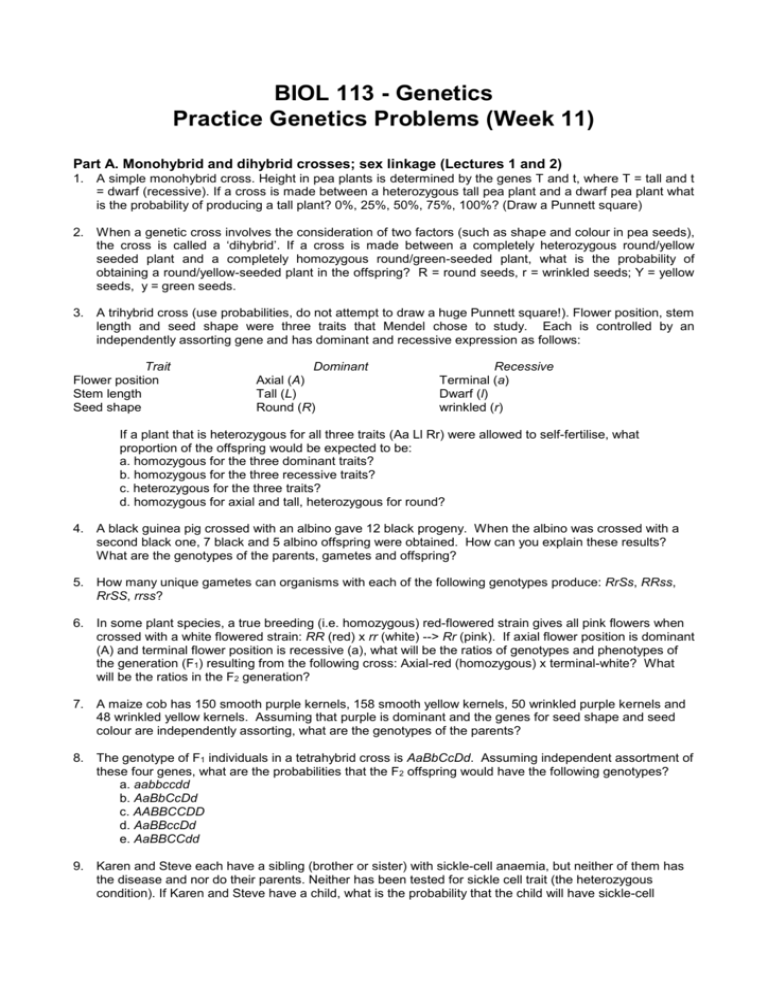
BIOL 113 - Genetics Practice Genetics Problems (Week 11) Part A. Monohybrid and dihybrid crosses; sex linkage (Lectures 1 and 2) 1. A simple monohybrid cross. Height in pea plants is determined by the genes T and t, where T = tall and t = dwarf (recessive). If a cross is made between a heterozygous tall pea plant and a dwarf pea plant what is the probability of producing a tall plant? 0%, 25%, 50%, 75%, 100%? (Draw a Punnett square) 2. When a genetic cross involves the consideration of two factors (such as shape and colour in pea seeds), the cross is called a ‘dihybrid’. If a cross is made between a completely heterozygous round/yellow seeded plant and a completely homozygous round/green-seeded plant, what is the probability of obtaining a round/yellow-seeded plant in the offspring? R = round seeds, r = wrinkled seeds; Y = yellow seeds, y = green seeds. 3. A trihybrid cross (use probabilities, do not attempt to draw a huge Punnett square!). Flower position, stem length and seed shape were three traits that Mendel chose to study. Each is controlled by an independently assorting gene and has dominant and recessive expression as follows: Trait Flower position Stem length Seed shape Dominant Axial (A) Tall (L) Round (R) Recessive Terminal (a) Dwarf (l) wrinkled (r) If a plant that is heterozygous for all three traits (Aa Ll Rr) were allowed to self-fertilise, what proportion of the offspring would be expected to be: a. homozygous for the three dominant traits? b. homozygous for the three recessive traits? c. heterozygous for the three traits? d. homozygous for axial and tall, heterozygous for round? 4. A black guinea pig crossed with an albino gave 12 black progeny. When the albino was crossed with a second black one, 7 black and 5 albino offspring were obtained. How can you explain these results? What are the genotypes of the parents, gametes and offspring? 5. How many unique gametes can organisms with each of the following genotypes produce: RrSs, RRss, RrSS, rrss? 6. In some plant species, a true breeding (i.e. homozygous) red-flowered strain gives all pink flowers when crossed with a white flowered strain: RR (red) x rr (white) --> Rr (pink). If axial flower position is dominant (A) and terminal flower position is recessive (a), what will be the ratios of genotypes and phenotypes of the generation (F1) resulting from the following cross: Axial-red (homozygous) x terminal-white? What will be the ratios in the F2 generation? 7. A maize cob has 150 smooth purple kernels, 158 smooth yellow kernels, 50 wrinkled purple kernels and 48 wrinkled yellow kernels. Assuming that purple is dominant and the genes for seed shape and seed colour are independently assorting, what are the genotypes of the parents? 8. The genotype of F1 individuals in a tetrahybrid cross is AaBbCcDd. Assuming independent assortment of these four genes, what are the probabilities that the F2 offspring would have the following genotypes? a. aabbccdd b. AaBbCcDd c. AABBCCDD d. AaBBccDd e. AaBBCCdd 9. Karen and Steve each have a sibling (brother or sister) with sickle-cell anaemia, but neither of them has the disease and nor do their parents. Neither has been tested for sickle cell trait (the heterozygous condition). If Karen and Steve have a child, what is the probability that the child will have sickle-cell anaemia? Clue: start by working out what the genotypes of Karen’s and Steve’s respective parents must be. 10. The normal daughter of a man with haemophilia (a recessive, sex-linked condition) marries a man who is not a haemophiliac. (a) What is the probability that a daughter will have haemophilia? (b) What is the probability that a son will have haemophilia? (c) If the couple have four sons, what is the probability that all four will be born with haemophilia? PART B. Gene linkage, recombination frequencies and linkage mapping (Lecture 3) 1. A wild-type fruit fly (heterozygous for grey colour and long wings: b+b vg+vg) was mated with a black fly with vestigial wings (bb vgvg). (Note that the wild-type allele in Drosphila is always designated by a superscript +). The offspring had the following distribution: grey long (wild type), 778; black vestigial, 785; black long, 158; grey vestigial, 162. What is the recombination frequency (= map distance) between the b and vg genes? 2. The cross in problem 11 was repeated with a different wild-type fly that was also heterozygous for body colour and wing length (b+b vg+vg). This time the progeny had the following distribution: wild type (grey long), 160; black vestigial, 162; black long, 770; grey vestigial, 780. What is the recombination frequency this time? How do you explain the difference between the relative numbers of different phenotypes in the two crosses (Draw the arrangement of the alleles on the heterozygous fly’s chromosomes in each of the two cases). Clue: think of ‘coupling’ and ‘repulsion’ heterozygotes. 3. In Drosophila the genes for red eyes (cn+) vs. cinnabar (cn), for normal bristle number (rd+) vs. reduced (rd) and for long wings (vg+) vs. vestigial (vg) are linked. A cross between a fly that was heterozygous for all three loci (cn+cn rd+rd vg+vg) and a triple homozygous recessive fly (cncn rdrd vgvg) gave the following numbers of each type of progeny: (see slides 24-27 in Lecture 3 handout) cinnabar, reduced, vestigial cinnabar, reduced, long cinnabar, normal, vestigial cinnabar, normal, long red, normal, long red, normal, vestigial red, reduced, long red, reduced, vestigial 406 46 28 3 438 45 33 1 Wild-type phenotypes are indicated in bold. Calculate the recombination frequencies between the three loci and construct a linkage map. Clue: take each pair of genes in turn (e.g. cn-rd) and work out the numbers of recombinants and the recombination frequency for that pair. 4. In Drosophila the genes for long bristles (sn+) vs. singed bristles (sn), for normal wings (cv+) vs. crossveinless wings (cv) and for red eyes (v+) vs. vermilion eyes (v) are linked. In a cross between a fly that was heterozygous for all three loci (sn+sn cv+cv v+v) and a triple homozygous recessive fly (snsn cvcv vv) gave the following numbers of each type of progeny: singed, crossveinless, vermilion long, crossveinless, vermilion long, normal, vermilion long, crossveinless, red singed, crossveinless, red singed, normal, vermilion singed, normal, red long, normal, red 3 392 34 61 32 65 410 3 Wild-type phenotypes are indicated in bold Calculate the recombination frequencies between the three loci and construct a linkage map. Clue: what do the numbers tell you about which are the parental genotypes?




